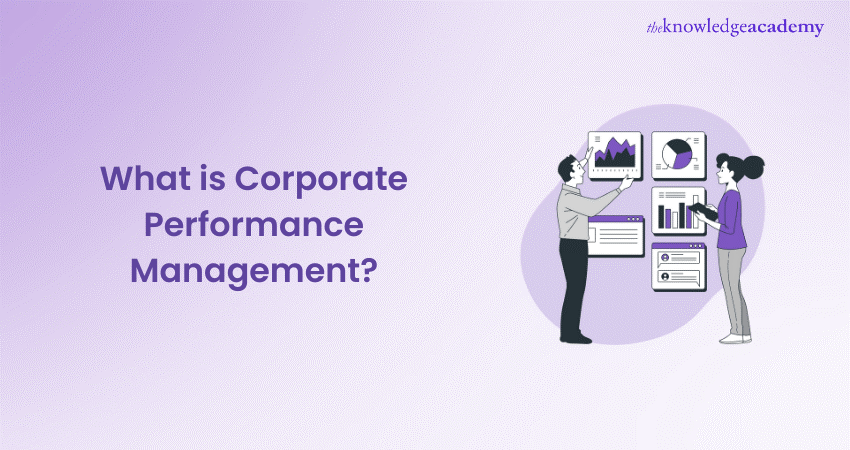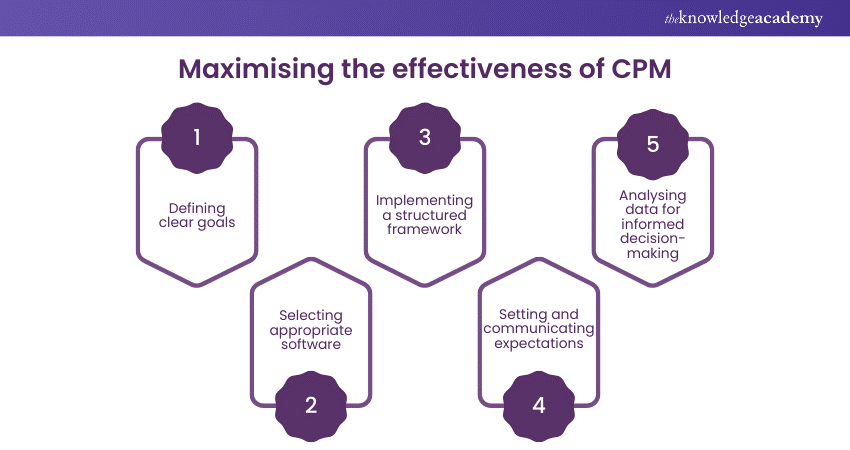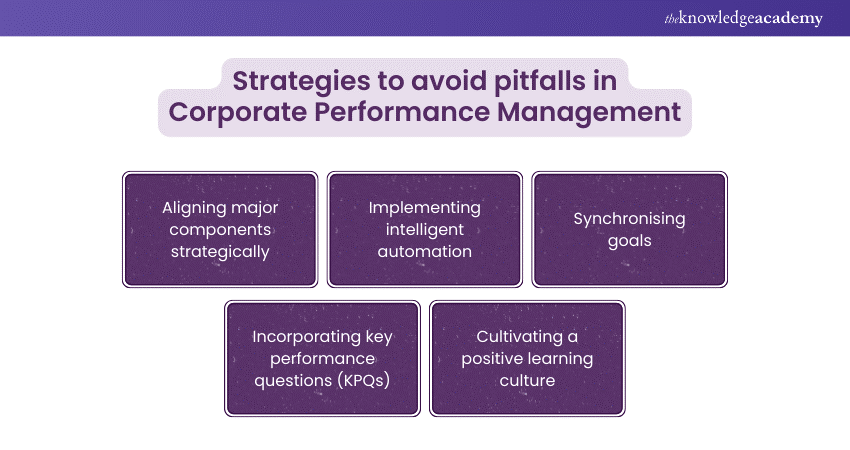We may not have the course you’re looking for. If you enquire or give us a call on 01344 203999 and speak to our training experts, we may still be able to help with your training requirements.
Training Outcomes Within Your Budget!
We ensure quality, budget-alignment, and timely delivery by our expert instructors.

Business entities continuously pursue avenues for enhancing their Performance and attaining strategic objectives. To do this, they employ the Corporate Performance Management (CPM) strategy to efficiently oversee, control, and enhance their Performance. Furthermore, various facets are associated with the CPM system.
Within this extensive blog, we will explore the importance of CPM and the optimal timing for its implementation. Additionally, we will emphasise its efficacy and provide guidance on selecting suitable CPM software.
Table of Contents:
1) What is Corporate Performance Management (CPM)?
2) The significance of Corporate Performance Management (CPM)
3) When to implement Corporate Performance Management?
4) Maximising the effectiveness of CPM
5) Strategies to avoid pitfalls in Corporate Performance Management
6) Distinguishing human performance Management from CPM
7) Tips for selecting an effective CPM software solution
8) Conclusion
What is Corporate Performance Management (CPM)?
Corporate Performance Management (CPM) is a structured framework that organisations use to align their goals with strategic objectives. It also encompasses various processes and methodologies aimed at improving decision-making. Additionally, it enhances operational efficiency and achieves desired business outcomes.
The significance of Corporate Performance Management (CPM)
Corporate Performance Management plays a pivotal role in contemporary times. Employing this system enables organisations to realise the following importance:
1) Insight
Corporate Performance Management (CPM) plays a pivotal role in providing organisations with valuable insights into their Performance metrics. CPM enables businesses to attain a thorough comprehension of their operations by analysing their Key Performance Indicators (KPIs). By identifying strengths, weaknesses, opportunities, and threats, organisations can make data-driven decisions. For instance, CPM may reveal how a specific product line can prompt a strategic shift in marketing efforts.
These further insights enable organisations to stay agile in a dynamic market, responding swiftly to changing trends and customer demands. CPM ultimately empowers leaders to make informed decisions and drive the organisation towards success.
2) Financial stability
Financial stability is a cornerstone of any successful organisation, and CPM plays a crucial role in achieving this stability. By closely monitoring financial Performance metrics such as revenue, expenses, and profitability, organisations can proactively manage their finances. For example, CPM may highlight areas where costs are exceeding budgeted amounts, prompting cost-saving measures.
Additionally, it can provide early warnings of potential financial risks, allowing organisations to take corrective actions before issues escalate. This proactive approach to financial Management ensures that organisations remain resilient in the face of economic uncertainties. CPM essentially helps organisations maintain financial stability, optimise resource allocation, and ensure sustainable growth.
3) Alignment with business objectives
One of the primary advantages of CPM lies in its capacity to synchronise individual and team objectives with business goals. This alignment also ensures that every effort within the organisation is directed towards achieving the overall strategic vision. For instance, CPM may highlight the Performance of specific departments or teams in relation to the company's growth targets.
This information better allows organisations to realign priorities, redistribute resources, and provide targeted support where needed. By fostering a sense of purpose and direction among employees, CPM creates a cohesive and motivated workforce. Ultimately, when team efforts are synchronised with organisational goals, the entire organisation moves towards success in a unified manner.
4) Strategic direction
Corporate Performance Management (CPM) enables organisations to set strategic priorities and allocate resources effectively to achieve these objectives. By scrutinising Performance data, organisations can detect emerging opportunities and potential market risks. For example, CPM may reveal a growing demand for a particular product category, prompting the organisation to invest more resources in its development and marketing.
Moreover, CPM furnishes a strategic blueprint for extended-term planning, steering decision-making across all tiers of the organisation. This strategic alignment ensures that resources are deployed efficiently, risks are mitigated, and growth opportunities are capitalised upon. Ultimately, CPM empowers organisations to navigate the complexities of the business landscape, ensuring sustained success in the long run.
Elevate efficiency and innovation with our Business Process Improvement Training – join us now
When to implement Corporate Performance Management System?
Deploying a CPM system offers numerous advantages. Organisations can implement them if they aim for the following factors:
a) Improve decision-making processes
b) Enhance operational efficiency
c) Align goals and objectives
d) Monitor and measure Performance
e) Drive accountability and transparency
Maximising the effectiveness of CPM
As mentioned earlier, CPM has various positive effects. The following aspects further enhance the efficiency of CPM in organisations:

1) Defining clear objectives
The cornerstone of effective Corporate Performance Management (CPM) lies in establishing clear and quantifiable objectives. Organisations should, thus, meticulously define specific objectives that align with their overarching strategy. These goals should be communicated clearly and consistently throughout the organisation to ensure everyone is working towards the same objectives. By setting clear goals, organisations provide employees with a clear direction and purpose, fostering motivation and focus.
2) Selecting appropriate software
Choosing the right CPM software is a critical step in maximising effectiveness. Organisations should, therefore, consider their unique needs and requirements when selecting a software solution. Factors such as scalability, integration capabilities with existing systems, ease of use, and robust reporting functionalities should all be considered. The selected software should seamlessly integrate with other systems, provide customisable reporting options, and offer user-friendly interfaces.
3) Implementing a structured framework
A structured CPM framework is essential for consistency and clarity in Performance Management. This includes clearly defining roles and responsibilities within the organisation and creating a feedback loop for continuous improvement. By implementing a structured framework, organisations ensure that Performance Management is conducted transparently, leading to more effective resource allocation.
4) Setting and communicating expectations
Transparent communication of expectations is vital for the CPM initiatives’ success. Employees should, therefore, have a clear understanding of what is expected of them and how their Performance is measured. This clarity enables employees to align their efforts with organisational objectives and motivates them to perform at their best. Additionally, managers should regularly guide employees to ensure they can meet expectations and address any Performance issues promptly.
5) Analysing data for informed decision-making
Data analysis lies at the heart of effective CPM. Organisations should leverage performance data to gain valuable insights into their operations and identify trends, opportunities, and areas for improvement. By analysing data, organisations can make informed decisions, forecast future Performance, and proactively address challenges. Advanced analytics tools can also provide scenario planning capabilities, enabling organisations to anticipate market changes and make strategic adjustments accordingly. Data-driven decision-making mostly enables organisations to optimise Performance and stay ahead of the competition.
Elevate your company's impact and reputation with our Corporate Social Responsibility (CSR) Training.
Strategies to avoid pitfalls in Corporate Performance Management
Corporate Performance Management (CPM) can face challenges that hinder its effectiveness. However, implementing the following strategies can help organisations overcome these pitfalls and achieve success:

1) Aligning major components strategically
To ensure the success of CPM initiatives, it's crucial to align all components strategically with the organisation's overarching goals. This includes setting clear goals that are connected to the strategic priorities of an organisation. Metrics and initiatives should also be aligned to support these goals by creating a cohesive approach towards achieving common objectives. Organisations can focus on activities that drive meaningful results and contribute to long-term success by ensuring strategic alignment.
2) Implementing intelligent automation
Leveraging automation tools is essential for streamlining CPM processes and reducing manual effort. Intelligent automation can also handle routine tasks to focus on more strategic activities. Organisations can improve efficiency, accuracy, and timeliness of Performance data by automating repetitive tasks. This not only saves time but also enhances the quality of insights generated. Intelligent automation also enables organisations to respond quickly to changes in the business environment, making CPM more adaptive and agile.
3) Synchronising goals
Regularly reviewing and updating goals is crucial to keep them relevant and aligned with evolving business conditions. Moreover, market dynamics and internal factors may necessitate adjustments to goals to keep them aligned with strategic priorities. Organisations can stay responsive and proactive by synchronising goals with changing business landscapes. This flexibility also allows for course corrections and ensures that efforts focus on contributing most effectively to organisational success.
4) Incorporating key Performance questions (KPQs)
Key Performance Questions (KPQs) are pivotal in focusing on critical areas of Performance and facilitating meaningful discussions within the organisation. These questions help identify key drivers of success and areas requiring attention or improvement. Organisations can gain deeper insights into what truly matters by incorporating KPQs into the Performance Management process. KPQs also guide discussions towards actionable insights, enabling informed decision-making and strategic planning.
5) Cultivating a positive learning culture
Fostering a culture centered on ongoing learning and enhancement is crucial for optimising the efficacy of CPM. Organisations should, therefore, provide opportunities for skill development, training, and feedback to employees at all levels. This fosters a culture where employees are encouraged to seek growth and development, leading to enhanced Performance. Recognition of achievements and contributions also plays a vital role in motivating employees and reinforcing positive behaviours. By creating a positive learning culture, organisations can empower their workforce to excel and drive organisational success.
Distinguishing human Performance Management from CPM
While Corporate Performance Management (CPM) and Human Performance Management (HPM) share a common goal, they focus on different aspects. Here are five key differences between the two:
a) Scope of focus: CPM primarily concentrates on organisational Performance, aligning goals and strategies to achieve desired outcomes. HPM, on the other hand, is more focused on individual and team Performance within the organisation. HPM emphasises developing the skills and capabilities of employees to enhance their contributions to organisational success.
b) Level of analysis: CPM involves analysing and monitoring key Performance metrics at an organisational level, such as financial Performance and strategic alignment. However, HPM involves a more granular analysis of individual and team performance metrics.
c) Goal alignment: In CPM, the emphasis is on aligning organisational goals with strategic objectives to ensure that efforts don’t remain useless. Whereas HPM focuses on aligning individual and team goals with organisational objectives. The HPM further makes employees understand how their contributions directly impact the organisation's goals.
d) Methods and strategies: CPM relies on strategies such as setting clear organisational goals, implementing Performance metrics, and using data analysis for decision-making. HPM, on the other hand, employs Performance appraisals, coaching and feedback mechanisms to enhance employee Performance and development.
e) Employee development: While CPM considers the impact of organisational strategies on employee Performance, its primary goal is to achieve overall organisational success. While HPM emphasise employee development and improve employee skills, engagement, and job satisfaction.
Tips for selecting an effective CPM software solution
Organisations should consider several factors to ensure it aligns with their goals and needs when choosing a CPM software solution. Here are some detailed tips to guide the selection process:
1) Consider scalability and integration capabilities: Scalability is crucial for a Corporate Performance Management software solution to grow alongside the organisation. Thus, organisations should consider whether the software can handle increased data volumes and user needs as the business expands. Additionally, integration capabilities are vital for seamless data flow between the CPM tool and other systems used by the organisation. A CPM solution that integrates well with existing software ensures a unified data environment and eliminates data silos.
2) Evaluate ease of use and user interface: The usability of a CPM software solution greatly impacts its effectiveness. A user-friendly interface and intuitive design further make it easier for employees to navigate the system and extract valuable insights. Hence, organisations should conduct a usability demo to assess how easily users can access and interpret data within the software. A visually appealing and intuitive interface can also encourage adoption and usage across the organisation.
3) Look for robust reporting and analytics features: The primary purpose of a CPM tool is to provide comprehensive insights into the organisation's Performance. In addition, robust reporting and analytics features are essential for generating meaningful reports. Thus, organisations must ensure the software offers multiple reporting options and customisable dashboards. Advanced analytics capabilities, such as predictive modelling or scenario planning, can also be valuable for strategic decision-making.
4) Assess vendor reputation and customer support: Selecting a reputable vendor is critical for the success of a CPM software implementation. Consequently, organisations must research the vendor's track record, customer reviews, and case studies to gauge their reputation and reliability. For instance, a vendor with a proven history of delivering quality solutions is more likely to provide a positive experience. Essentially, a responsive and knowledgeable support team can help address issues promptly and ensure a smooth implementation process.
Conclusion
By providing valuable insights and enabling informed decision-making, CPM plays a crucial role in driving organisational success. To maximise the effectiveness of Corporate Performance Management, organisations should define clear goals and analyse data for informed decision-making. Overall, CPM empowers organisations to achieve their strategic goals and adapt to changing market dynamics.
Master the art of successful conferences with our Conference Management Course – join us now!
Frequently Asked Questions

Corporate Performance encompasses assessing a company's achievements and progress toward strategic goals. It also enables informed decision-making and ensures alignment with objectives for sustained success.

A CPM tool is a software facilitating the Management, analysis, and monitoring of Performance metrics. This tool also aids organisations in making informed decisions and optimising operational efficiency. With its comprehensive reporting and analytics features, it helps organisations to adapt improvement strategies.

The Knowledge Academy takes global learning to new heights, offering over 30,000 online courses across 490+ locations in 220 countries. This expansive reach ensures accessibility and convenience for learners worldwide.
Alongside our diverse Online Course Catalogue, encompassing 17 major categories, we go the extra mile by providing a plethora of free educational Online Resources like News updates, Blogs, videos, webinars, and interview questions. Tailoring learning experiences further, professionals can maximise value with customisable Course Bundles of TKA.

The Knowledge Academy’s Knowledge Pass, a prepaid voucher, adds another layer of flexibility, allowing course bookings over a 12-month period. Join us on a journey where education knows no bounds.

The Knowledge Academy offers various Management Courses, including Management Training for New Managers, Corporate Social Responsibility CSR Training and Managing Projects Remotely Training. These courses cater to different skill levels, providing comprehensive insights into Successful Planning.
Our Business Skills Blogs cover a range of topics related to Performance Management, offering valuable resources, best practices, and industry insights. Whether you are a beginner or looking to advance your Business skills, The Knowledge Academy's diverse courses and informative blogs have got you covered.
Upcoming Business Skills Resources Batches & Dates
Date
 Organisational Skills
Organisational Skills
Fri 31st May 2024
Fri 26th Jul 2024
Fri 27th Sep 2024
Fri 29th Nov 2024









 Top Rated Course
Top Rated Course



 If you wish to make any changes to your course, please
If you wish to make any changes to your course, please


